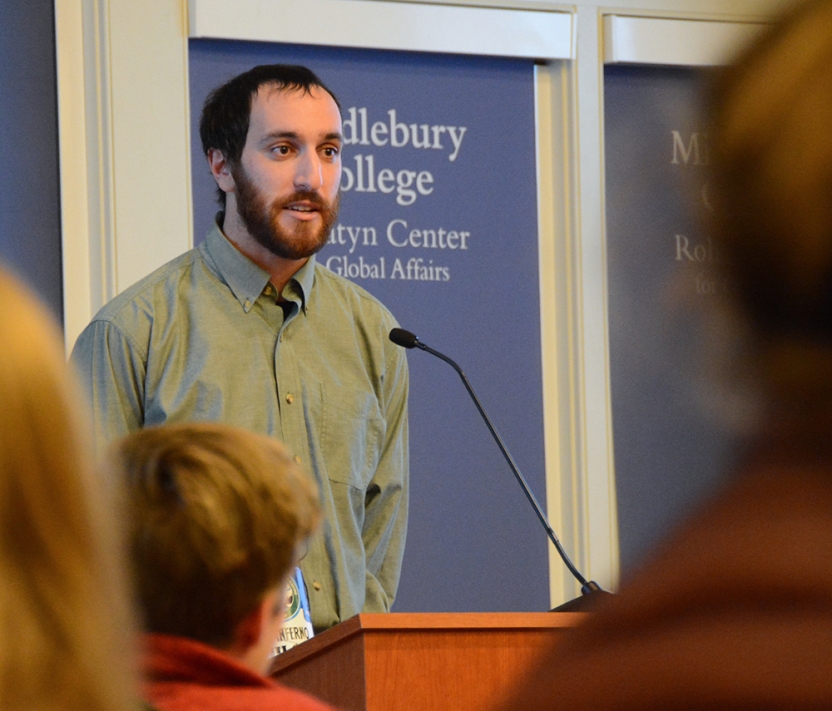"We Lost Our Sea Ice, Now What?"

MIDDLEBURY, Vt. – Ross Lieb-Lappen ’07, a postdoctoral fellow with the U.S. Army Corps of Engineers’ Cold Regions Research and Engineering Laboratory, discussed the decline of sea ice in the Arctic Ocean, in a talk at the Rohatyn Center for Global Affairs on January 30.
In the opening remarks to “We Lost Our Sea Ice, Now What?” Lieb-Lappen pointed out an important distinction between summer sea ice and winter sea ice:
“To put everyone’s fears to rest, in our lifetimes we will probably always have winter sea ice in the Arctic. So when we talk about losing our sea ice, we are talking about an Arctic without any summer sea ice. To be sure, the winter sea ice will always continue to be there.”
Lieb-Lappen ’07, who majored in environmental studies and chemistry at Middlebury before earning a master’s degree in mathematics at the University of Vermont and a doctorate in engineering from Dartmouth, returned to campus in January to teach the winter term course Ice Cores: By Land and By Sea.
Exactly how much summer sea ice has been lost? About 1.5 million square miles, and to demonstrate this Lieb-Lappen said the area of Arctic summer sea ice lost between 1980 and 2012 is equal to about half of the area of the United States, or all of the east coast, the Midwest, and the Dakotas.
That means that about 1.5 million square miles of the Arctic Ocean that used to be frozen in the summer is now open for shipping, exploration, and tourism – all of which are certain to have an effect upon the environment of the region, he said.
During the course of his 40-minute illustrated lecture, Lieb-Lappen avoided offering his opinions about climate change, with a few exceptions. He said the melting of Arctic sea ice will not raise the level of the Earth’s oceans, but the melting of glacial ice in the Arctic – “some of which is 800,000 years old and up to 2 miles thick” – will cause sea levels to rise and, presumably, have an adverse effect on oceanfront land areas.
He also said Arctic sea ice forms when it’s about 30 degrees F. and even at its coldest level sea ice rarely gets below 10 degrees F. “So sea ice is always going to be a fragile material that can quickly turn into liquid with even a very small change in temperature. That’s part of the reason why we use it as a proxy for temperature.”
“[Sea ice] is the canary in the coal mine. It is our first indication of how the climate is changing because it going to be the first material to change… For those of us in Vermont, we are noticing that the sugaring season has changed. When I was at Middlebury it was unheard of to be sugaring in January, and that’s not that long ago. Now you have to have your taps in by January because that’s when [the maple sap] is flowing. We see changes in other regions of the world, but sea ice is always going to be a first indicator because it is such a fragile material.”
Lieb-Lappen, who primarily uses x-ray micro-computed tomography to study the microstructure of soils, snow, and ice for the Army Corps of Engineers, also discussed the different scales of sea ice, the properties of salt found in summer ice vs. multi-year ice, and how the “ice-albedo feedback loop” is affecting temperatures in the Arctic.
With regard to the political and economic issues raised by the loss of sea ice in the Arctic, Lieb-Lappen said these are intriguing geopolitical questions because as many as eight countries can lay a claim to the region: United States, Russia, Canada, Denmark (Greenland), Norway, Sweden, Finland, and Iceland.
The guest speaker also discussed why Antarctica is not losing its sea ice. “The South Pole is different than the North Pole partly because of the physical geography of the two areas: one is a continent surrounded by ice while the other is an ocean surrounded by land. And the difference also has to do with the circulation patterns in the ocean and in the atmosphere [in Antarctica], as we are learning in our J-term class.”
Lieb-Lappen closed with a slide showing vast areas of open water in the Arctic Ocean and a quote from Waleed Abdalati, NASA’s former chief scientist, who said, “Human civilization has never known a time when there has not been sea ice in the Arctic in the summer. We appear to be approaching that time.”
The lecture in the Robert A. Jones ’59 House was cosponsored by Middlebury’s Environmental Studies Program and the Franklin Environmental Center.

